Art & Exhibitions
Harvard to Unveil Forgotten Mark Rothko Murals
The series has been sitting in storage since the 1970s.
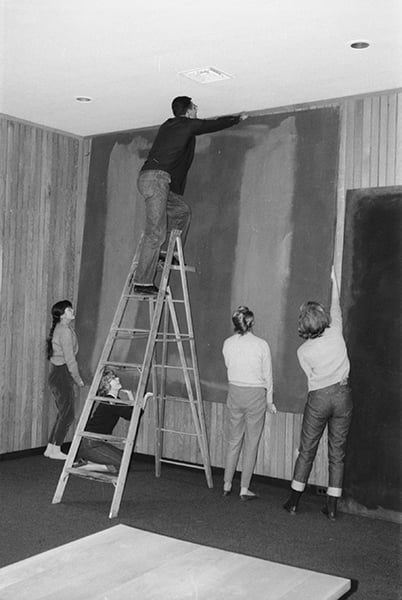
The series has been sitting in storage since the 1970s.

Sarah Cascone


Mark Rothko, Panel Five (Harvard Mural) (1962), digitally restored from 1964.
Harvard Art Museums/Fogg Museum, transfer from Harvard University, gift of the artist, © 1998 Kate Rothko Prizel and Christopher Rothko / Artists Rights Society (ARS), New York, courtesy President and Fellows of HarvardCollege.
As the Harvard Art Museums look forward to their November reopening, they are also preparing for the newly renovated and expanded facility’s inaugural exhibition, “Mark Rothko’s Harvard Murals.”
The university commissioned the artist to create a series of murals in the 1960s. Unfortunately, the canvases were displayed in a room with floor-to-ceiling windows, and the steady exposure to bright sunlight caused the works’ vibrant colors to fade over time. Eventually, they were removed to storage and largely forgotten.
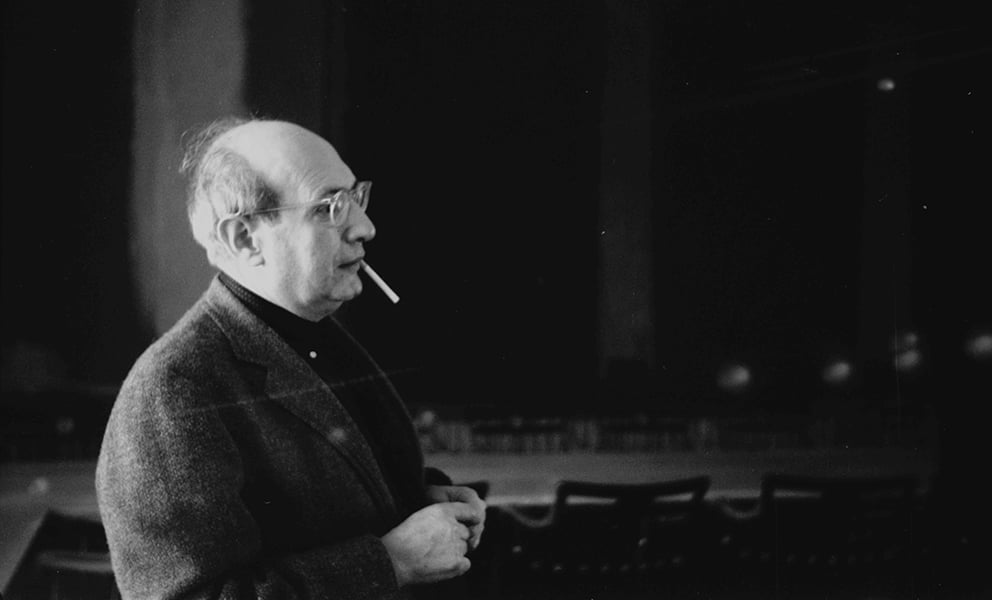
Mark Rothko in front of Panel Two and Panel Three of the Harvard Murals, Holyoke Center, January 1963.
Photo: Elizabeth H. Jones, courtesy President and Fellows of Harvard College.
Despite the old saying “out of sight, out of mind,” the university was mindful of the art historical value of the works, and, in 2013 applied for and received an AXA ART Conservation Research Grant. AXA provides research support for conservation projects, and helped Harvard with technical analysis and the development of a brand new methodology for conserving the Rothko murals.
Thanks to the grant funding, Harvard was able to conduct innovative research and technical analysis, inventing a light-based conservation and treatment methodology for Mark Rothko’s Harvard Murals that utilizes custom-made software, as well as a system employing a camera and a projector.
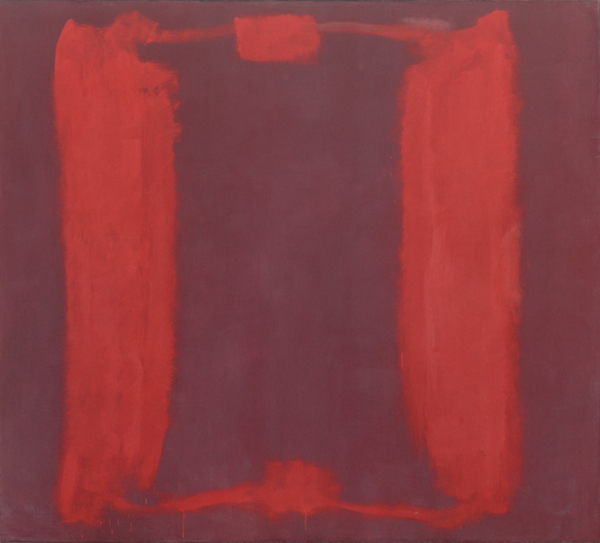
Mark Rothko, Panel Five (Harvard Mural) (1962), digitally restored from 1964.Harvard Art Museums/Fogg Museum, transfer from Harvard University, gift of the artist, © 1998 Kate Rothko Prizel and Christopher Rothko / Artists Rights Society (ARS), New York, courtesy President and Fellows of Harvard College.
Unlike traditional restoration methods, which involve physically altering the original work, the Harvard project did not work with paints or pigments to readjust the work’s hue or tone. Instead, a light-based method of noninvasive restoration tailored specifically to the Rothkos’ needs was specially created.
Recent photos of each mural were analyzed and compared to 1960s-era images depicting the original, unfaded color. Next, a “compensation image” was calibrated and sent to a digital projector that overlaid colored light that illuminated the paintings and restored their intended appearance, pixel by pixel.
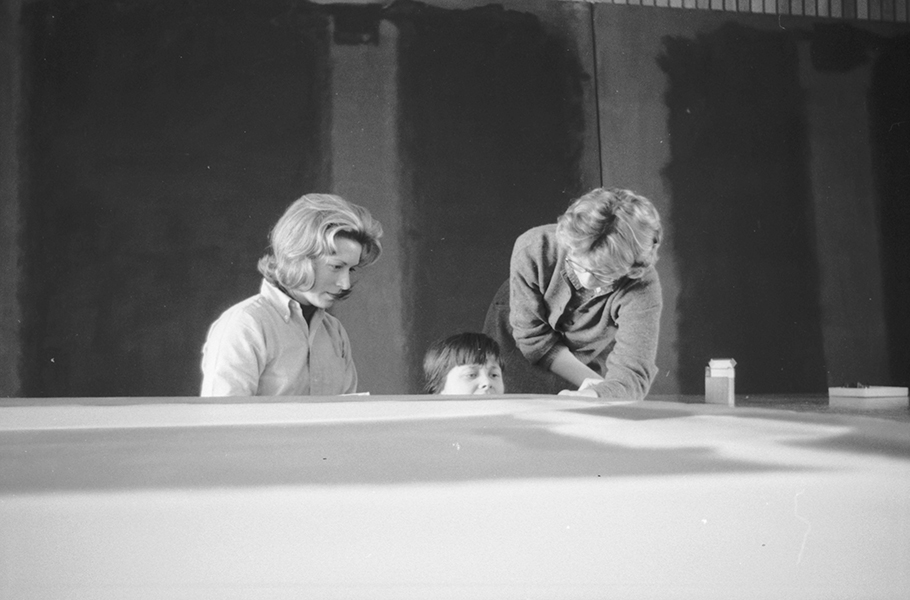
Conservators Jean Lampton (Woodward), Marjorie Cohn, and Sue Ellen Crampton stretching Panel Five, in front of Panel Two and Panel Three of the Harvard Murals, Holyoke Center, January 1963.
Photo: Elizabeth H. Jones, courtesy President and Fellows of Harvard College.
A group of art historians, conservation scientists, conservators, and scientists at Harvard, the MIT Media Lab, and the University of Basel, Switzerland, teamed up to complete the restoration and its accompanying research. The five Rothko murals will soon be ready to go back on display as part of an exhibition that will reveal the pioneering computer-based techniques used to restore the paintings’ formerly rich colors.

Conservators Marjorie Cohn, Sue Ellen Crampton, Gregory Smyrlian, Rhoda Burden, and Jean Lampton (Woodward) installing Panel One of the Harvard Murals, Holyoke Center, January 1963.
Photo: Elizabeth H. Jones, courtesy President and Fellows of Harvard College.
Visitors will be treated to a time capsule view of the illuminated canvases, now bearing their original colors. The projectors will also be turned off at least once each day, providing the opportunity to study the unadulterated canvases and to truly grasp the nature of the groundbreaking restoration.
The five Harvard Murals will be returned to their original home in the penthouse dining room of Harvard University’s Holyoke Center, in the same configuration they were first installed, fifty years ago, in 1964. A sixth Rothko completed for the project but never exhibited will also be on display, as well as related drawings and studies for a total of 38 works by the artist.
“Mark Rothko’s Harvard Murals” will be on view November 16, 2014, through July 26, 2015.
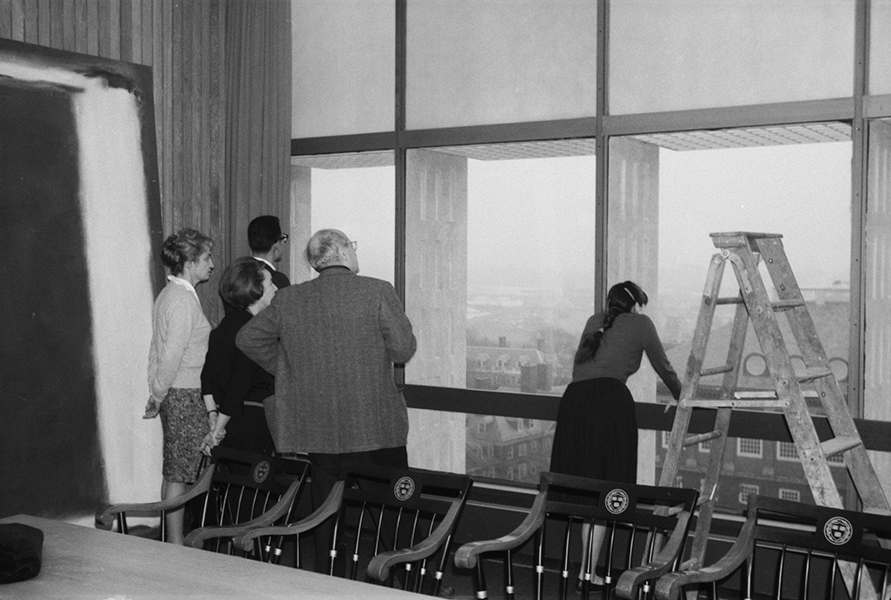
Rhoda Burden, Estelle Leontief, Gregory Smyrlian, Mark Rothko, and Marjorie Cohn, with Panel Five of the Harvard Murals, Holyoke Center, January 1963. Photo: Elizabeth H. Jones, courtesy President and Fellows of Harvard College.